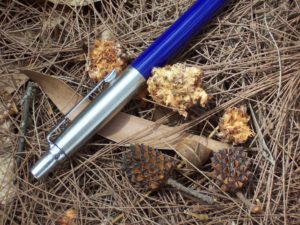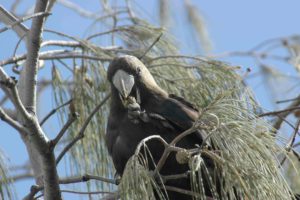The Glossy Black Conservancy is currently looking for volunteers to assist with annual monitoring efforts throughout the north-east New South Wales and south-east Queensland region. Monitoring routinely takes place via the annual Birding Day, with events held in May or October in alternating years. In addition to this members of the community are encouraged to report sightings of Glossy Black-Cockatoo outside of these specific event days through the online reporting system.
The Glossy Black Conservancy has various training programs and activities that emphasise Community Awareness and education about the the birds. You may wish to contact some of the local councils to express your interest in awareness activities.
Go bird-watching in your local area
Glossy Black-Cockatoos are quite widespread but use habitats that provide sufficient foraging resources for them. Target these areas and look and listen for the signs of the species, such as chew marks on fallen she-oak cones (orts) and the distinctive sound of cockatoos chewing on the seeds.You can report sightings of birds as well as feeding evidence using the online reporting system.

Protect the habitat of the Glossy Black-Cockatoo
If you have she-oaks on your property – don’t clear them, they may provide important feeding resources for Glossy Black-Cockatoos now as well as into the future. Glossy Black-Cockatoo are know to return to reliable feeding sites and even specific trees so make sure to retain these trees and surrounding roosting habitat. You can also contribute by planting up new trees to provide resources that might be lost in other areas through ongoing development. See your garden, school grounds or local regeneration site as habitat for the cockatoo and plant Glossy Black-Cockatoo food trees. The property can be big or small, size does not matter.

Habitat trees for roosting and nesting are also particularly important, especially those large old eucalyptus with big hollows. Try and retain these trees and keep an eye out to see what animals might be using the hollows. While it is possible to install nest boxes these efforts should not be undertaken without due consideration of issues such as the density of natural hollows in the area, the types of species that might make use of the nest boxes, what type of nest box monitoring program will be undertaken. Nest boxes have certainly been used to good effect in some areas to assist with the recovery of Glossy Black-Cockatoo populations (e.g. Kangaroo Island), but these efforts are supported by intensive monitoring programs.

Start, or become involved in a local cockatoo friends group
Improving our knowledge of local populations of Glossy Black-Cockatoo will give us a better understanding of the performance of the regional population of cockatoo. There are already some well known areas that have regular sightings being reported by groups of dedicated observers but there could be others, they may simply not have been found yet. If you’re interested in getting to know your local birds in a bit more detail the Glossy Black Conservancy can provide some suggestions as to how to develop a monitoring program for your local birds.

I have been a birdwatcher all over Australia-. I found night parrots west of Cloncurry around 1990.When we moved South in 2000 g. b cockatoos used to visit the trees on our aquerage block but it is 5 years since any have appeared.
When walking in casuarina groves it’s helpful to listen for quiet crunching sounds. If approached slowly and quietly, glossies will often let you get reasonably close while they continue feeding – close enough to determine their gender.
We see a family of three in different parts of the Noosa National Park, alerted by feeding sounds or their call, less piercing and raucous than the yellow-tailed black cockatoos that frequent the park as well. We feel privileged, but very concerned for the future of our local glossy population because of proposed development in the few feeding grounds left in this area.
Hi, I regularly hear and see pairs of Glossy black cockatoos feeding for hours in casuarinas in the Newcastle area. I usually report them through inaturalist.
Do you pickup these sightings for your studies or should I enter them separately?
They have become more common in the last two years.
Hi Karen,
Thanks for reaching out.
That’s a really great question. Conservancy partners are currently in discussions with other stakeholders about this very matter. We are determined to ensure all recordings are where they need to be so decision makers have the information they need, especially regarding land planning. We are working toward a national strategy.
For now, we are using the Birdata platform with the intent to share our data with other platforms used by governments.
I would suggest that inaturalist is a good place to record your sightings without having to double up on other platforms.
Thanks again and keep up the great work!
I have been living in Beechmont in Queensland for 40 years and have seen many Glossy Black-Cockatoos over the years at many different locations. I have reported sightings on the Conservancy website and Bird Data. Some of these locations are used frequently e.g in May they feed on Allocasuarina torulosa in Lamington National Park about 4kms from Binna Burra on the Coomera falls track and on a group of Casuarinas beside the Beechmont Road at a lookout about 6kms from Binna Burra and about 500m south of Beechmont Estate.
At these, and other regularly visited locations, they feed for a few days then move to other locations. These flocks usually include one or two adult pairs and one or two juveniles but on one occasion a flock of 11 flew over my house.
However, this year has been different. On June 4th an adult pair and a solitary bird were seen, by a very observant local walker, feeding on a Casuarina tree at the Binna Burra Road Lookout mentioned above. The adults were seen flying away but the solitary bird stayed and came back to that tree almost every day until July 12th. An adult pair joined it for one day only. They fed in the tree the solitary bird had been using whilst it fed on a Casuarina on the other side of the road. The next day he was alone again and back on his favourite tree on the Eastern side of the road. There were thousands of cones on the tree and when it was feeding on branches above the road orts were raining down on to the bitumen. I stood underneath and got showered with chewings. Today, July 15th, the bird has been gone for 3 days and most of the cones have been eaten so it probably won’t come back even though there are many other Casuarinas nearby bearing abundant cones. I think the terms serotiny and bradyspory , the slow release of seeds over time, may account for the birds ignoring seemingly, to us, mature cones. Even though I observed what I assume was the same bird for over a month with binoculars and a scope, and often at close range, it never stretched out its wings or tail or flew when it was in its favourite tree so I only saw a very small red patch on one tail feather. This made it difficult to determine the birds age or even its sex. The absence of yellow on the head suggest it isn’t a female. However, on the day the adult pair was present and ‘my’ bird was in a different tree I got a brief flash of the tail feathers which showed some barring which suggests it could possibly been immature male.
I have never seen a Glossy Black-Cockatoo feed in the same tree for such a long time and was wondering if there are other records of them having done so?